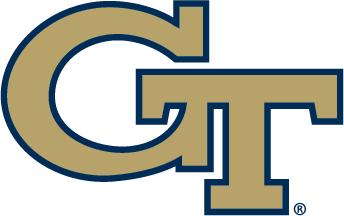Dec. 14, 2004
ATLANTA – Georgia Tech, ranked No. 3 in the Associated Press and ESPN/USA Today rankings this week, tried for its seventh straight win Wednesday night when it hosts James Madison at 7 p.m. at Alexander Memorial Coliseum.
The regionally televised meeting (FSN South) is just the second meeting between the two schools, and the first encounter for Tech head coach Paul Hewitt against a former assistant, JMU’s Dean Keener, who was on Hewitt’s staff from 2000-04.
Radio coverage is provided by the Georgia Tech/ISP Sports Network, and can be heard in Atlanta on WQXI-AM (790) and WREK-FM (91.1). The game can also be heard nationally on XM Satellite Radio (Channel 180).
Tech (6-0) comes into the game on a roll, having won its six games by an average of 25.7 points, and its last four games by an average of 29.0. The Yellow Jackets came out of fall semester exams with a 64-42 win over Air Force last Saturday at Philips Arena, and defeated Michigan (99-68) and Georgia (87-49) in the two games prior to that.
The Dukes (2-3) won their first two games of the season over LaSalle and Maryland-Baltimore County, but have lost three straight games since, including a 77-53 defeat at Virginia Tech Saturday.
QUICK LOOK AT TECH
Chief among Tech’s returning players are five seniors – 6-4 guard B.J. Elder (Madison, Ga.), Tech’s leading scorer who is currently averaging 18.7 points per game, fifth-best in the ACC; 6-6 forward Isma’il Muhammad (Atlanta, Ga.), averaging 8.7 points and 6.8 rebounds per game; 6-7 forward Anthony McHenry (Birmingham, Ala.), Tech’s underrated power forward averaging 4.5 points and 3.8 rebounds per game; 7-1 center Luke Schenscher (Hope Forest, South Australia), averaging 10.2 points and a team-high 8.2 rebounds per game; and 6-0 guard Will Bynum (Chicago, Ill.), averaging 9.3 points and 3.0 assists.
They are joined by one of the nation’s best point guards, 6-3 junior Jarrett Jack (Fort Washington, Md.), averaging 13.3 points and 5.0 assists per game while also hitting 61.4 percent of his field goal attempts and 94.7 percent of his free throws.
From those six have come Tech’s starting five in each game so far. Muhammad and Bynum alternated in the starting lineup except for the Georgia game on Dec. 5, when both started and McHenry came off the bench. Jack, Elder and Schenscher have started all six games.
Elder, a preseason candidate for the Wooden and Naismith player of the year awards, has taken on a greater share of Tech’s scoring load and has shot the ball better over Tech’s last four-and-a-half games. The senior made 10 of 12 shots from the floor, including 7-of-9 from three-point range, for 27 points against Michigan in his best performance of the season, then went 8-of-14 for a game-high 19 points against Georgia, and was 4-for-6 for 11 points against Air Force. Elder also hit a trio of big three-point baskets in the final 10 minutes of Tech’s win at Illinois-Chicago, which proved to be the Yellow Jackets’ only field goals during that stretch, then went 4-for-8 from three-point range against UALR.
Jack, making a case for himself as one of the nation’s top point guards, scored 16 points and dished out a season-high 11 assists without committing a turnover in 30 minutes against Michigan, then went 7-for-7 with three threes for 18 points against Georgia. Schenscher posted his first double-double of the season against Georgia with 12 points and 14 rebounds, and has reached double figures in scoring three straight games, averaging 12.3 points and hitting 60 percent of his shots over that stretch.
THE CAVALRY
Tech is getting quality help off the bench from 6-9 junior Theodis Tarver (Monroe, La.), who has played very well throughout preseason practice and shown no ill effects from the dislocated knee that kept him out of 13 games last season. Tarver has averaged 3.5 rebounds and has blocked 10 shots in six games while averaging 12.7 minutes.
Mario West, a 6-4 guard from Douglasville, Ga., gives the Jackets a lift defensively, and has averaged 2.5 rebounds in little more than six minutes per game.
Tech’s freshman class, rated No. 2 in the ACC by Bob Gibbons, is coming along slowly but will provide needed help in various roles. The Yellow Jackets’ depth from this group took a blow, however, when Jeremis Smith, a 6-6 forward from Fort Worth, Texas, suffered a dislocation of his right kneecap late in the Arkansas-Little Rock game on Nov. 26 and is out indefinitely. Smith had averaged 4.5 rebounds and 2.0 points in two games.
Ra’Sean Dickey, a 6-9 forward-center from Clio (pronounced KLY-oh), S.C., combines with Schenscher and Tarver to give the Jackets good size and strength at the center position. In 10 minutes on the floor against Georgia, Dickey scored 12 points (3-3 FG, 6-7 FT) pulled down six rebounds and blocked two shots. He is 9-for-12 from the floor this season and has blocked four shots.
Zam Fredrick, a 6-0 guard from St. Matthews, S.C., and Anthony Morrow, a 6-5 guard from Charlotte, N.C., can supply added scoring punch from the perimeter. Morrow hit two threes against Michigan, while Fredrick played a season-high 16 minutes, drained 2-of-3 from behind the three-point arc and had two assists.
QUOTING COACH HEWITT
On JMU and its head coach Dean Keener – “He’s doing a great job, but right now, he’s beset by injuries. I’m not really sure if you’re going to see how they want to play right now, given the injuries. I know his teams are going to be strong defensively. He was the guy who helped me mold my philosophy about defense. So his teams are going be very aggressive defensively.
“I think if they were healthy, they’d be pretty good. They’re playing hard. You can tell how much the guys believe in what you’re doing by how hard they play. If they get healthy by the time they start the league season, don’t be surprised if they make a run at the league.”
On Tech’s performance against Air Force – “In the first half, I thought we did a very good job managing all those decisions, with all the communicating we had to do on the screens and how to play their personnel. I’m not sure we can play a whole lot better, defensively, than we did in the first half. In the first half also, we wanted to get Luke going and we got him some key touches early. In the second half I thought we got a little selfish. This team, by nature, is not selfish, so for us to get a little unselfish, we really look bad when we do that. Consequently, we end up with 13 turnovers and no quality looks from the three-point line. Instead of driving and making the extra pass out to an open three, we kept forcing it. As I told them after the game, we’re not playing just to win a game, we’re trying to see how much this team can improve and how good we can be. In the second half, I’m not going to say we took a step back because Air Force certainly played extremely well, but we didn’t take advantage of our opportunity to improve.”
On Zam Fredrick – “He can score. His intelligence, in terms of understanding the game, and in the classroom, stood out to me. I expect him to be one of the leaders of this program. His grades (in high school) were off the charts. On the court, you could see he was a guy the other kids gravitated to.
“He had a tough start. But he has a lot of pride. He has a pretty good legacy to follow. I’m sure everyone in South Carolina expects him to lead the nation in scoring one day (as his father did at South Carolina). Early on, when he wasn’t playing as much, and he wasn’t playing as well in practice, I think he kind of let it get to him. But he’s bounced back and done a nice job of recovering from that. We asked him to lose some weight when he came, and he got down to about 205. He played really well against Georgia, because his quickness started to come out.”
TECH VS. JAMES MADISON
> Dukes head coach Dean Keener is in his first season at the Harrisonburg, Va., school after serving as an assistant coach at Tech for four seasons. The Yellow Jackets went to two NCAA Tournaments and one NIT during his tenure on the Flats. He succeeded another former Tech assistant coach in Sherman Dillard. On Keener’s staff at JMU is Jon Babul, a former Tech player (graduated in 2001) who is the Duke’s director of operations.
> Jeff Bourne, JMU’s director of athletics, is a former senior associate AD at Tech, and the Dukes’ head baseball coach, Joe “Spanky” McFarland, is a former Tech baseball assistant coach.
> Tech’s only prior meeting with JMU came in the first round of the 1991 Preseason NIT, a 93-69 Yellow Jacket victory. The Jackets went on to defeat Colorado State in the second round and Texas in the semifinals before falling to Oklahoma State in the championship game.
> Tech is 15-2 all-time against current members of the Colonial Athletic Association. The Jackets played Hofstra and VCU last year, both wins for Tech. The two losses occurred to Hofstra (in 1998) and William & Mary (in 1973).
SHOOTING STRAIGHT
Georgia Tech’s shooting from the floor has steadily improved over the six games it has played, and dramatically so between the first two games and the last four. The Yellow Jackets started slow, hitting just 40.8 percent from the floor against Alabama State and Illinois-Chicago, and 53.0 percent since.
Tech has been above 50 percent each of the last three games (55.4 percent aggregate), the first time the Jackets have accomplished that since last December. After hitting 54.2 percent from the floor against Michigan, Tech managed 53.6 percent against Georgia and 60 percent against Air Force.
Now at 48.9 percent for the season, Tech ranks third in the ACC in field goal percentage.
Likewise, Tech has improved dramatically from three-point range since going 4-for-21 at Illinois-Chicago. The Yellow Jackets have shot 43.6 percent from behind the stripe in the last four games (despite going 0-for-2 Saturday against Air Force), and stand at 35.5 percent for the season.
STREAK OVER
After 546 straight games of making at least one three-point field goal, a streak covering 17 years, Georgia Tech failed to make one against Air Force, misfiring on both attempts. The Yellow Jackets did not even try one in the second half.
The fact that Tech tried only two speaks to the way the game went against the Falcons. The Jackets continually looked inside for easy shots from Luke Schenscher, who went 6-for-9. Tech’s four post players combined to go 13-for-18 from the floor, and the Jackets scored 40 of their 64 points in the paint.
“It’s not necessarily important, but there’s always a reason why things happen to a team,” said head coach Paul Hewitt. “For us to only have two three-point attempts was a combination of the fact that in the first half, we wanted to go inside, and in the second half, we didn’t pass the basketball. We’ve got great shooters, as you’ve guys have seen, but when we don’t pass the basketball, then you end up with what you had today in the second half.”
> Tech tried only 40 shots overall, making 24 for 60 percent, its best percentage game of the season.
> The three-point shot has been in existence 18 seasons, counting this one. In that first season, Tech failed to try even one in six games, and tried only one in two others. The Jackets had tried no fewer than three in any game since then until Saturday.
> From the 1989-90 season forward, Tech has tried less than 10 three-point field goals only 14 times. Since the 1993-94 season, that had happened only once until Saturday.
TECH STOCK TIPS
> Tech squeaked out a one-point victory at Illinois-Chicago, but has won its other four games by an average of 30.6 points.
> Tech has won 28 of its last 31 games against non-ACC teams.
> Tech’s top five scorers are all shooting 46.7 percent or better from the floor, three at 50 percent or higher. B.J. Elder ranks 11th in the ACC at an even 50 percent, the only Tech player with enough field goals made per game to qualify for the league rankings. Jarrett Jack (61.4 percent) and Luke Schenscher (59.5 percent) would rank third and fifth, respectively, if they had enough field goals to qualify.
> Tech’s three centers (Luke Schenscher, Theodis Tarver, Ra’Sean Dickey) have made 55.5 percent of their field goals.
> Tech, which historically has struggled from the free throw line early in the season, got off to a poor start again this year. But like past seasons, the Jackets have warmed up, hitting 76.2 percent from the stripe against Air Force and 69.8 percent in the last three games combined.
> Tech has blocked 42 shots in six games, an average of 7.0 per game that ranks second in the ACC. That has helped limit Tech’s opponents to just 32.7 percent from the floor, best in the ACC. The Jackets also top the league in three-point defense (24.1 percent) and are also first in scoring defense (51.5).
> Tech’s last three opponents have gone 2-for-17 (Arkansas-Little Rock), 4-for-15 (Michigan), 3-for-14 (Georgia) and 7-for-33 (Air Force), respectively, from three-point range.
> Tech has rebounded well, outboarding its opponents by an average of 11.7 per game which leads the ACC, and have outrebounded every opponent by at least six.
> Tech has 114 assists on 174 field goals, a rate of 65.5 percent, and ranks second in the ACC in assist average (19.0 per game).
> Tech faces seven non-conference opponents that played in the post-season last year. The Yellow Jackets have already played Alabama State, Illinois-Chicago and Air Force, all of whom of whom played in the NCAA Tournament, as well as Michigan and Georgia, which played in the NIT. Tech will face Gonzaga in Las Vegas and Kansas in Lawrence before commencing ACC play.
GOT THE RUNS
Georgia Tech has taken control of each game, except Illinois-Chicago, with an extended run of strong defense. To wit:
> Tech opened its game against Alabama State by holding the Hornets scoreless for the first 8:18, and led 24-8 with 4:46 to go in the first half. The Jackets also did not allow a point over the final 8:59 of that game.
> Tech allowed Arkansas-Little Rock only two points over the first 10 minutes (a 23-2 run) and led 32-8 at one point.
> Leading 10-9 with 16:58 showing in the first half against Michigan, Tech scored the next 20 points and held the Wolverines scoreless for 4-1/2 minutes.
> Tech outscored Georgia 36-9 in the first 15 minutes of the second half Sunday night, expanding a 43-30 halftime lead to 79-39.
> Tech allowed Air Force only six points in the first 11:30 of the game, building a 24-6 lead, then outscored the Falcons 8-1 heading into intermission for a 32-12 halftime advantage.
DEFENSE CARRYING JACKETS
Defensive pressure, both half-court and full-court, was the catalyst for Georgia Tech all last season and has remained so throughout the first part of Tech’s 2004-05 campaign. Tech has allowed its two opponents to shoot just 32.7 percent (only Michigan has managed 40 percent), which is the best in the ACC.
> Among Tech’s last four opponents, the best percentage one has been able to achieve is 26.7 percent (4-for-15 by Michigan), and those four have made only 20.3 percent from beyond the arc. For the season, Tech has allowed 24.1 percent, the lowest yield in the ACC.
> Tech has forced 16.2 turnovers per game thus far, blocked 7.0 shots and taken 8.2 steals per game. Its rebounding rate of 43.2 leads the ACC.
> Tech has allowed only 17 teams in its last 43 games to shoot 40 percent or better from the floor. Only four have reached 50 percent.
> Tech’s stout defense is not a new phenomenon. The Yellow Jackets ranked first in the ACC in field goal percentage defense in all games (38.8 pct.) last season, were first in league games only (40.8 pct.), and were the sixth-best in NCAA Division I basketball. Tech also led the ACC in both three-point percentage defense in all games (29.7 pct.) and was first league games only (32.2 pct.).
TECH IN THE THRILLERDOME
Georgia Tech is playing its 49th season at Alexander Memorial Coliseum at McDonald’s Center, and the Jackets have a record of 482-163 (.747) in the building, which opened Nov. 30, 1956 with a 71-61 Tech loss to Duke. Since the 1981-82 season, Tech is 244-62 (.797) in its on-campus home.
The Yellow Jackets were 12-3 at home last season, and have won 31 of their last 36 games in the Thrillerdome dating back to the final two home games of 2001-02.
Tech is 138-8 against non-conference opposition at Alexander Memorial Coliseum since the beginning of the 1981-82 season. Three of those eight losses occurred in the 2001-02 season to Penn, Tulane and IUPUI. From 1981 through last season, the only other non-ACC teams to win at the Thrillerdome were Georgia (2000), Penn State (1998), College of Charleston (1993), Louisville (1989), and Richmond (1987).
Georgia Tech played to sellout crowds every home game after its run to the Preseason NIT championship, and that included all of Tech’s home games during the break between fall and winter semesters. The Thrillerdome has been sold out for this entire season since early summer.









